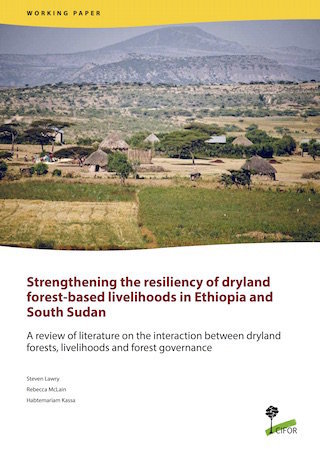Women and forests: does their involvement matter?
This brief article documents author's reasons for considering the answer to be "yes." She draws first on her extensive ethnographic experience in forest communities in the US and in several forested areas of Indonesia, with examples. Her second source of conviction in this view comes from her involvement in a comparative study of criteria and indicators in Africa, Asia and South America, in which she visited many forested areas around the world.
Where are the poor and where are the trees?: targeting of poverty reduction and forest conservation in Vietnam
This paper highlights the spatial linkages of forest quality with poverty incidence and poverty density in Vietnam. Most of the Vietnamese poor live in densely populated river deltas and cities while remote upland areas have the highest poverty incidences, gaps, and severities. Forests of high local and global value are located in areas where relatively few poor people live, but where the incidence, gap, and severity of poverty are strongest, and where the livelihood strategies are based on agricultural and forest activities.
Where are the poor and where are the trees?: targeting of poverty reduction and forest conservation in Vietnam (Vietnamese)
This paper highlights the spatial linkages of forest quality with poverty incidence and poverty density in Vietnam. Most of the Vietnamese poor live in densely populated river deltas and cities while remote upland areas have the highest poverty incidences, gaps, and severities. Forests of high local and global value are located in areas where relatively few poor people live, but where the incidence, gap, and severity of poverty are strongest, and where the livelihood strategies are based on agricultural and forest activities.
Where the power lies: multiple stakeholder politics over natural resources: a participatory methods guide
This manual is a participatory methods guide (1) to assist those involved with multiple stakeholder situations or groups to appreciate and acknowledge the relevance and impact of micro-politics on stakeholder relations and resultant cooperative behaviour in these groups; (2) to provide a simple and systematic approach or framework to gather and analyse data on micro-politics among multiple stakeholders; (3) to highlight and offer practical suggestions for dealing with some of the methodological issues that influence gathering data on politics and relations among stakeholders; (4) to suggest
Who counts most in sustainable forest management?
This paper proposes a method for identifying and defining the most significant actors in sustain- able forest management. A rationale for the importance of differentiating among various forest stakeholders is first provided. Significant stakeholders identified in forest management units in Kalimantan, Côte d'Ivoire, and the USA. are described.
Strengthening the resiliency of dryland forest-based livelihoods in Ethiopia and South Sudan
This literature review explores how political, economic and resource management policies and programs can reduce forest degradation and increase the contribution of forest goods and services to sustainable livelihood strategies. In Ethiopia, studies indicate that forest dependency is strong throughout the country, but the importance of forest income varies across different regions and wealth categories. Research suggests that improving forest product market governance is key to strengthening forest livelihood resiliency.
Overview of Forest Law Enforcement, Governance and Trade - Baseline Study 4 - Myanmar
Table of Contents:-
1. EXECUTIVE SUMMARY AND MAJOR FINDINGS …
2. HISTORICAL OVERVIEW ...
3. NATIONAL FOREST STRATEGY, POLICIES AND REGULATIONS:
3.1 The Myanmar Selection System and Annual Allowable Cut;
3.2 Forest Law and Policy ;
3.3 Forest Land Categories;
3.4 Community Forestry;
3.5 Impact of Forest Law Enforcement on Local People...
4. DEMAND: DOMESTIC DEMAND AND WOOD EXPORTS:
4.1 Domestic Demand ;
4.2 Exports ...
5. TIMBER SUPPLY: DOMESTIC PRODUCTION AND WOOD IMPORTS:
5.1 Domestic Wood Production;
A Study of the Role of Forest and Forest-Dependent Community in Myanmar
... This study was intended to find out the benefits of forests, especially for non-wood forest products (NWFPs), to forestdependent local people and the relation to their socio-economic status. Sampling (169 respondents) was chosen to be an equal distribution of household’s economic status. The survey was conducted face to face with structural interviews using both open-and closed-ended questions. The results showed that bamboo and bamboo shoot were considered as the most collected NWFPs in the Bago Yoma region.
Exploring the Socio-Economic Situation of Plantation Villagers: A Case Study in Bago Yoma
... Massive scale plantation forestry in Myanmar began in the early 1980s as a drastic measure to fulfil the increasing demand for timber and to prevent the conversion of deteriorated forestland to agricultural land. More than 30,000 ha of forest plantations have annually been formed since 1984 (Myanmar Forest Department 2000). Myanmar has also launched a Special Teak Plantation Program in 1998 which has an annual plantation target of 8000 ha in addition to the normal plantation scheme.
Myanmar's Rosewood Crisis: Why Key Species and Forest Must be Protected Through CITES
... Extremely rapid growth in Chinese imports of ‘redwood’, ‘rosewoods’ or ‘Hongmu’ timbers from Myanmar in the past two years is directly driving increased illegal and unsustainable logging, posing a real threat to governance, the rule of law and the viability Myanmar’s dwindling forests. EIA research shows that, based on current trends, the two most targeted Hongmu species in
Myanmar - tamalan and padauk - could be logged to commercial extinction in as little as three years.



